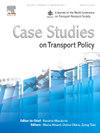Changes in the determinants of travel demand for the Washington DC Metrorail system after COVID-19: Evidence from a replication study
IF 2.4
Q3 TRANSPORTATION
引用次数: 0
Abstract
The COVID-19 pandemic influenced many changes to daily lifestyles, including public transportation ridership. To accommodate changes in ridership patterns, it is important to consistently update knowledge of the factors that most influence a rider’s decision to use public transportation. Origin-Destination Direct Ridership Models are one of the methods used to accomplish this, as they examine the sensitivity of transit demand to changes across a series of explanatory variables. This study replicated a time-of-day, multi-level Origin-Destination Land Use Ridership Model (OD-LURM), previously developed using 2014 ridership data, with 2022 SmarTrip card data from the Washington, D.C. Metrorail System. Directly comparing model results from 2014 and 2022, the magnitudes of the effects of various determinants on Metrorail ridership were examined, considering three different groups of variables at the level of origin stations, destination stations, and OD-station pairs. The effects of the total number of jobs within a half-mile radius, parking users, parking capacity, bus line counts, and median household income on ridership in the AM peak, PM peak, and off-peak time periods were reduced compared to the previous study, sometimes drastically. The results also indicated a weaker model fit using the updated data. Overall, this replication study provides new context behind changes in post-pandemic ridership, and the results suggest persistent changes in travel behavior since the pre-pandemic period. The findings of this study could be used to inform transit-oriented development, fare structures, and service levels in the D.C. metropolitan area post-pandemic.
COVID-19 后华盛顿特区地铁系统出行需求决定因素的变化:复制研究的证据
COVID-19大流行影响了人们日常生活方式的许多变化,包括公共交通乘客。为了适应乘客模式的变化,不断更新对乘客决定使用公共交通的影响因素的认识是很重要的。始发目的地直接乘客模型是用来实现这一目标的方法之一,因为它们检查了交通需求对一系列解释变量变化的敏感性。该研究采用华盛顿特区地铁系统的2022年SmarTrip卡数据,复制了一个基于时间的、多层次的出发地-目的地土地使用客流量模型(OD-LURM),该模型之前是使用2014年的客流量数据开发的。直接比较2014年和2022年的模型结果,考虑始发站、目的站和始发站对水平上的三组不同变量,研究了各种因素对地铁客流量的影响程度。与之前的研究相比,半英里半径内的工作总数、停车用户、停车容量、公交线路数量和家庭收入中位数对早高峰、晚高峰和非高峰时段客流量的影响有所降低,有时甚至大幅降低。结果还表明,使用更新数据的模型拟合较弱。总的来说,这项重复性研究提供了大流行后客流量变化背后的新背景,结果表明,自大流行前时期以来,旅行行为发生了持续变化。这项研究的结果可以用来为大流行后华盛顿大都会区以交通为导向的发展、票价结构和服务水平提供信息。
本文章由计算机程序翻译,如有差异,请以英文原文为准。
求助全文
约1分钟内获得全文
求助全文

 求助内容:
求助内容: 应助结果提醒方式:
应助结果提醒方式:


